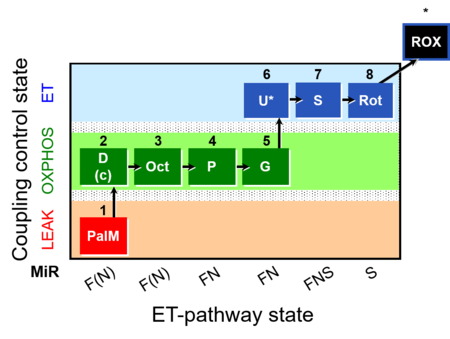Difference between revisions of "Template:SUIT-019"
From Bioblast
| Line 11: | Line 11: | ||
| [[Fatty acid oxidation pathway control state| F(N)]] | | [[Fatty acid oxidation pathway control state| F(N)]] | ||
| CETF | | CETF | ||
| | | 1PalM | ||
{{Template:SUIT F}} {{Template:SUIT L(n)}} | *{{Template:SUIT F}} | ||
*{{Template:SUIT L(n)}} | |||
|- | |- | ||
| Line 22: | Line 23: | ||
| 1PalM;2D | | 1PalM;2D | ||
{{Template:SUIT F}} {{Template:SUIT OXPHOS}} | *{{Template:SUIT F}} | ||
*{{Template:SUIT OXPHOS}} | |||
|- | |||
| 2c | |||
| [[PalM]]<sub>''P''</sub> | |||
| [[Fatty acid oxidation pathway control state| F(N)]] | |||
| CETF | |||
| 1PalM;2D;2c | |||
*{{Template:SUIT c}} | |||
*{{Template:SUIT F}} | |||
*{{Template:SUIT OXPHOS}} | |||
|- | |- | ||
| Line 29: | Line 42: | ||
| [[Fatty acid oxidation pathway control state| F(N)]] | | [[Fatty acid oxidation pathway control state| F(N)]] | ||
| CETF | | CETF | ||
| 1PalM;2D;3Oct | | 1PalM;2D;2c;3Oct | ||
{{Template:SUIT F}} {{Template:SUIT OXPHOS}} | *{{Template:SUIT F}} | ||
*{{Template:SUIT OXPHOS}} | |||
|- | |- | ||
| Line 38: | Line 52: | ||
| [[FN]] | | [[FN]] | ||
| CETF&I | | CETF&I | ||
| 1PalM;2D;3Oct;4P | | 1PalM;2D;2c;3Oct;4P | ||
{{Template:SUIT F}} & {{Template:SUIT N}} {{Template:SUIT FN}} {{Template:SUIT OXPHOS}} | *{{Template:SUIT F}} & {{Template:SUIT N}} | ||
*{{Template:SUIT FN}} | |||
*{{Template:SUIT OXPHOS}} | |||
|- | |- | ||
| Line 47: | Line 63: | ||
| [[FN]] | | [[FN]] | ||
| CETF&I | | CETF&I | ||
| 1PalM;2D;3Oct;4P;5G | | 1PalM;2D;2c;3Oct;4P;5G | ||
{{Template:SUIT F}} & {{Template:SUIT N}} {{Template:SUIT FN}} {{Template:SUIT OXPHOS}} | *{{Template:SUIT F}} & {{Template:SUIT N}} | ||
*{{Template:SUIT FN}} | |||
*{{Template:SUIT OXPHOS}} | |||
|- | |- | ||
| Line 56: | Line 74: | ||
| [[FN]] | | [[FN]] | ||
| CETF&CI&II | | CETF&CI&II | ||
| 1PalM;2D;3Oct;4P;5G;6U | | 1PalM;2D;2c;3Oct;4P;5G;6U | ||
{{Template:SUIT F}} & {{Template:SUIT N}} {{Template:SUIT FN}} {{Template:SUIT U*}} {{Template:SUIT ET}} | *{{Template:SUIT F}} & {{Template:SUIT N}} | ||
*{{Template:SUIT FN}} | |||
*{{Template:SUIT U*}} | |||
*{{Template:SUIT ET}} | |||
|- | |- | ||
| Line 65: | Line 86: | ||
| [[FNS]] | | [[FNS]] | ||
| CI&CII | | CI&CII | ||
| 1PalM;2D;3Oct;4P;5G;6U;7S | | 1PalM;2D;2c;3Oct;4P;5G;6U;7S | ||
{{Template:SUIT F}} & {{Template:SUIT N}} {{Template:SUIT FN}} {{Template:SUIT S}} {{Template:SUIT ET}} | *{{Template:SUIT F}} & {{Template:SUIT N}} | ||
*{{Template:SUIT FN}} | |||
*{{Template:SUIT S}} | |||
*{{Template:SUIT ET}} | |||
|- | |- | ||
| Line 74: | Line 98: | ||
| [[S]] | | [[S]] | ||
| CII | | CII | ||
| 1PalM;2D;3Oct;4P;5G;6U;7S | | 1PalM;2D;2c;3Oct;4P;5G;6U;7S;8Rot | ||
{{Template:SUIT Rot}} {{Template:SUIT S}} {{Template:SUIT ET}} | *{{Template:SUIT Rot}} | ||
| | *{{Template:SUIT S}} | ||
*{{Template:SUIT ET}} | |||
|- | |||
| 9Ama | |||
| ROX | |||
| | |||
| | |||
| 1PalM;2D;2c;3Oct;4P;5G;6U;7S;8Rot;9Ama | |||
*{{Template:SUIT Ama}} | |||
|} | |||
{{Template:SUIT CIV}} | {{Template:SUIT CIV}} | ||
{{Template:Keywords in SUIT protocols}} | {{Template:Keywords in SUIT protocols}} | ||
Revision as of 15:29, 28 January 2019
Steps and respiratory states
| Step | State | Pathway | Q-junction | Comment - Events (E) and Marks (M) |
|---|---|---|---|---|
| 1PalM | PalML | F(N) | CETF | 1PalM
|
| 2D | PalMP | F(N) | CETF | 1PalM;2D
|
| 2c | PalMP | F(N) | CETF | 1PalM;2D;2c
|
| 3Oct | PalOctMP | F(N) | CETF | 1PalM;2D;2c;3Oct
|
| 4P | PalOctPMP | FN | CETF&I | 1PalM;2D;2c;3Oct;4P
|
| 5G | PalOctPGMP | FN | CETF&I | 1PalM;2D;2c;3Oct;4P;5G
|
| 6U | PalOctPGME | FN | CETF&CI&II | 1PalM;2D;2c;3Oct;4P;5G;6U
|
| 7S | PalOctPGMSE | FNS | CI&CII | 1PalM;2D;2c;3Oct;4P;5G;6U;7S
|
| 8Rot | SE | S | CII | 1PalM;2D;2c;3Oct;4P;5G;6U;7S;8Rot
|
| 9Ama | ROX | 1PalM;2D;2c;3Oct;4P;5G;6U;7S;8Rot;9Ama
|
| Step | Respiratory state | Pathway control | ET-Complex | Comment |
|---|---|---|---|---|
| ## AsTm | AsTmE | CIV | CIV | |
| ## Azd | CHB |
- Bioblast links: SUIT protocols - >>>>>>> - Click on [Expand] or [Collapse] - >>>>>>>
- Coupling control
- Pathway control
- Main fuel substrates
- » Glutamate, G
- » Glycerophosphate, Gp
- » Malate, M
- » Octanoylcarnitine, Oct
- » Pyruvate, P
- » Succinate, S
- Main fuel substrates
- Glossary

